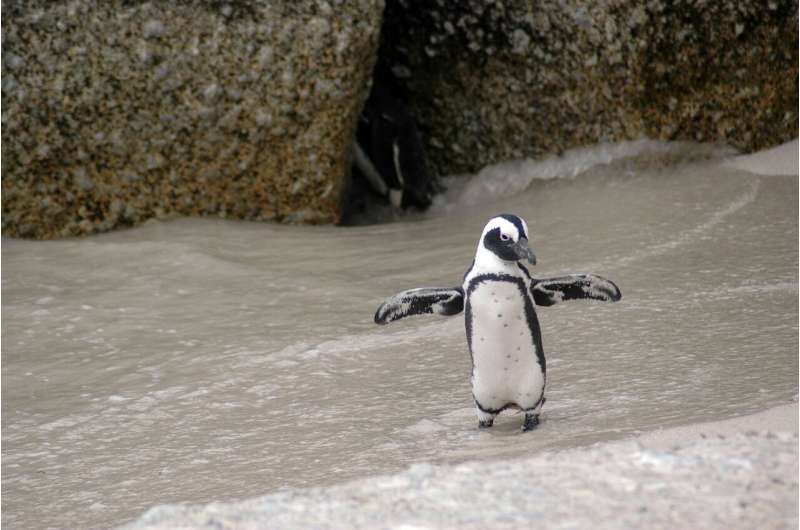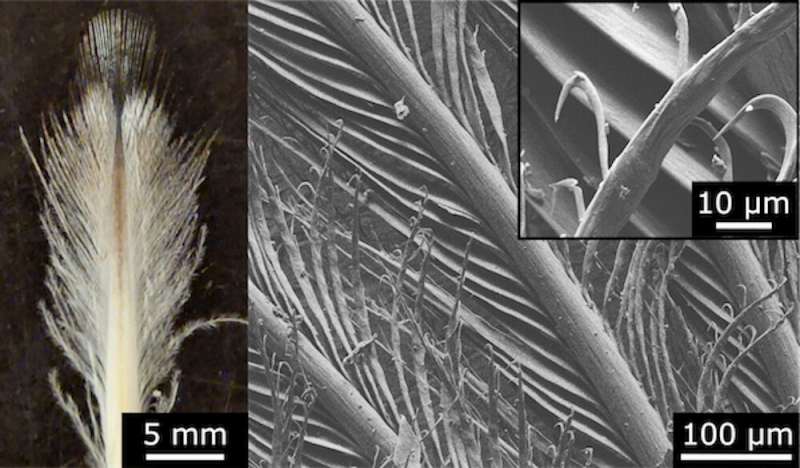

Penguin feathers help inspire new de-icing techniques
source link: https://techxplore.com/news/2023-01-penguin-feathers-de-icing-techniques.html
Go to the source link to view the article. You can view the picture content, updated content and better typesetting reading experience. If the link is broken, please click the button below to view the snapshot at that time.

January 12, 2023
Penguin feathers help inspire new de-icing techniques
by Anne-Marie Kietzig and Michael John Wood, The Conversation

Walking down a road during a white winter comes with its own set of challenges: the frigid cold, stepping around slippery ice on roads and the need to switch sidewalks to avoid dagger-sharp icicles that could potentially fall from above.
This accumulated ice on roofs and rain gutter overhangs is not merely an annoyance and danger, but also requires tremendous efforts to remove. Standard ice removal techniques rely on mechanical, thermal or chemical action.
The ice on road signs, electrical transmission pylons and cables is removed by hitting the ice slabs to induce vibrations to the object or by bending the structure.
Airplanes are sprayed with de-icing fluids that chemically melt and prevent the formation of ice before take-off. And like heated sidewalks, airplane wings are typically heated in flight to melt ice that can form on their leading edges.
While all these anti-icing approaches are necessary to avoid fatal infrastructure failure and accidents, these techniques are unsustainable as they require tremendous amounts of energy and harmful chemicals. Over the past few decades, researchers have tried to develop passive anti-icing technology—a surface that would not allow ice to form on it or would require very little effort to dislodge any small inconsequential pieces of ice that did.
Our team of researchers at McGill University's Biomimetic Surface Engineering Laboratory looked to nature for these solutions. Nature takes a different approach to solving its icy surface problems. Through millennia, species have adapted to possess an array of surface functions that do not require harsh chemistry or huge amounts of energy input. We found the solution to de-icing challenges in the feathers of adorable wobble-gaited penguins.
Reading between the feathers
When we set out to develop a passive anti-icing surface last winter, we thought about how penguins have never been photographed with a big ice crust on their plumage, despite living in really cold environments, swimming and hunting in frigid waters and standing in high winds.
We contacted the Montréal Biodome—which showcases different ecosystems—and visited their sub-Antarctic exhibit with Gentoo penguins. They also gave us a jar full of shed Gentoo feathers.
We studied the microstructure and wetting behavior of individual feathers and also reassembled them into a feather mat to study whether or not they attract ice. Wetting behavior characterizes how water droplets behave on the surface. Basically, it checks whether droplets roll off like tiny soccer balls or spread out in a puddle or whether the outcome is something in between.
Our analysis showed that the penguin's plumage has both water-shedding and ice-shedding properties. The preening oil that the bird applies when it grooms itself did not appear to play a role in ice-shedding. This led us to suspect that these effects come from the structure of its feathers, which meant that the structure of penguin feathers could provide a radically different approach to creating surface designs with passive anti-icing properties.
The detailed features of every individual feather and the role of the hamuli—a part of the feather that hooks individual feathers together into a mat—inspired us to replicate this natural wire-like mesh of a structure using woven textiles.

In order to mimic the microstructure of the penguin feathers we observed, we selected stainless steel cloths with wire diameters and pore sizes similar to those of the feathers. We also used our ultrafast laser processing equipment to match the longitudinal nano-sized grooves seen on the barbs and barbules of the penguin feather's structure.
Creating water- and ice- repelling surfaces
Our research found that while a water-repellent surface is a definite requirement for stainless steel mesh cloth to shed water, this requirement becomes less important as the temperature decreases.
This is because water actually penetrates the previously empty mesh pores and freezes slowly as the temperatures drop low, creating cracks in the ice surface. This means that the surface can easily repel water and ice at freezing temperatures.
This is in contrast to the majority of water-repellant surfaces that mimic air-trapping as seen in lotus leaves (lotus effect), where water penetration often strengthens the adhesion of ice.
Our biomimetic mesh surfaces—which mimicked penguin feathers with a woven stainless steel textile—showed about 95% decreased ice adhesion strength compared to polished smooth monolithic stainless steel.
This extremely good ice-shedding performance can be attributed to the shape of the microstructure pores, the openings of which are smaller than the actual empty space inside the pore.
These pore openings get closed off first by growing ice, which traps still liquid water inside. That enclosed water freezes slowly in comparison to the water on the outside. As it freezes, it can expand by around 9% in its confined space, ultimately creating cracks along every single pore of the wire cloth. These cracks help any ice build up to shed off easily.
A de-icing strategy for the future
While our study approaches the problem of ice accumulation from a different perspective than all previous studies, it provides potential new de-icing solutions to a problem that affects our lives every winter.
Clearly, we need more investigations and developments before critical infrastructure such as aircraft or power lines solely rely on passive de-icing solutions like these.
However, we can implement them alongside traditional active heating systems for less-critical applications like street signs in the foreseeable future. This will allow us to investigate the long-term stability of such textured surfaces, their installation and maintenance costs, and whether or not it curbs the energy and chemical requirements of today's de-icing techniques.
This article is republished from The Conversation under a Creative Commons license. Read the original article.
Recommend
-
 142
142
mod_md - ACME for Apache This repository contains mod_md, a module for Apache httpd that helps you to manage your domains. What is it good for? mod_md does two things: Provide
-
 24
24
Michael Feathers finds errors fascinating, but acknowledges that most developers don't spend a lot of time focusing on them. He also thinks most error handling is kind of giving up. Although best known for his book,
-
 59
59
Michael Feathers因其著作《高效操作遗留代码》( Working Effectively With Legacy Code )一书而广为人知。他发现错误中存在着一些值得关注之处,但...
-
 15
15
Announcing Feathers-Vuex 3.14.0
-
 21
21
-
 7
7
Introducing Feathers 4: A framework for real-time apps and REST APIsToday I’m happy to share the release of Feathers 4 (Crow), a framework for real-time applications and REST APIs with JavaScript and TypeScript. 🐦 🎉
-
 15
15
England to Become First Country in World To Prescribe VapesNew guidelines from health experts mean that e-cigarettes will be prescribed on the NHS to cut smoking rates, despite warnings of the dangers of vaping...
-
 13
13
In another article we’ll look at the things that are on the move and planned for 2019 but first, here is what happened since the fall update.Feathers Cor...
-
 7
7
About this Episode Another toaster strudel debate?! Plus, the results are in for the most listened-to podcast in the RoR community! :: drum roll :: Steph has a "Dear Gerrit" messag...
-
 10
10
The icing on the cake: baked goods, AI, and lessons in user adoptionWhat the evolution of cake mix could tell us about future trends in AI.
About Joyk
Aggregate valuable and interesting links.
Joyk means Joy of geeK